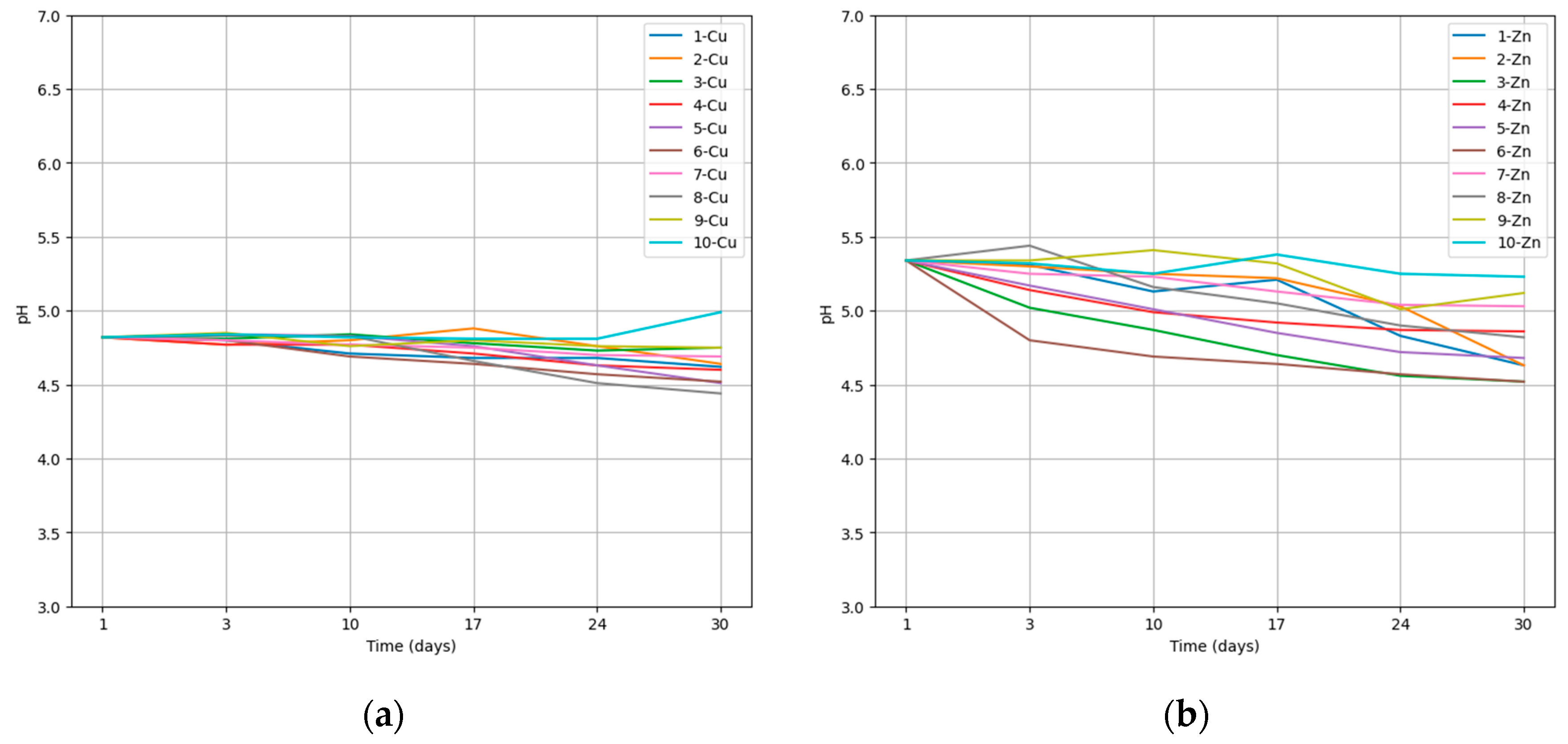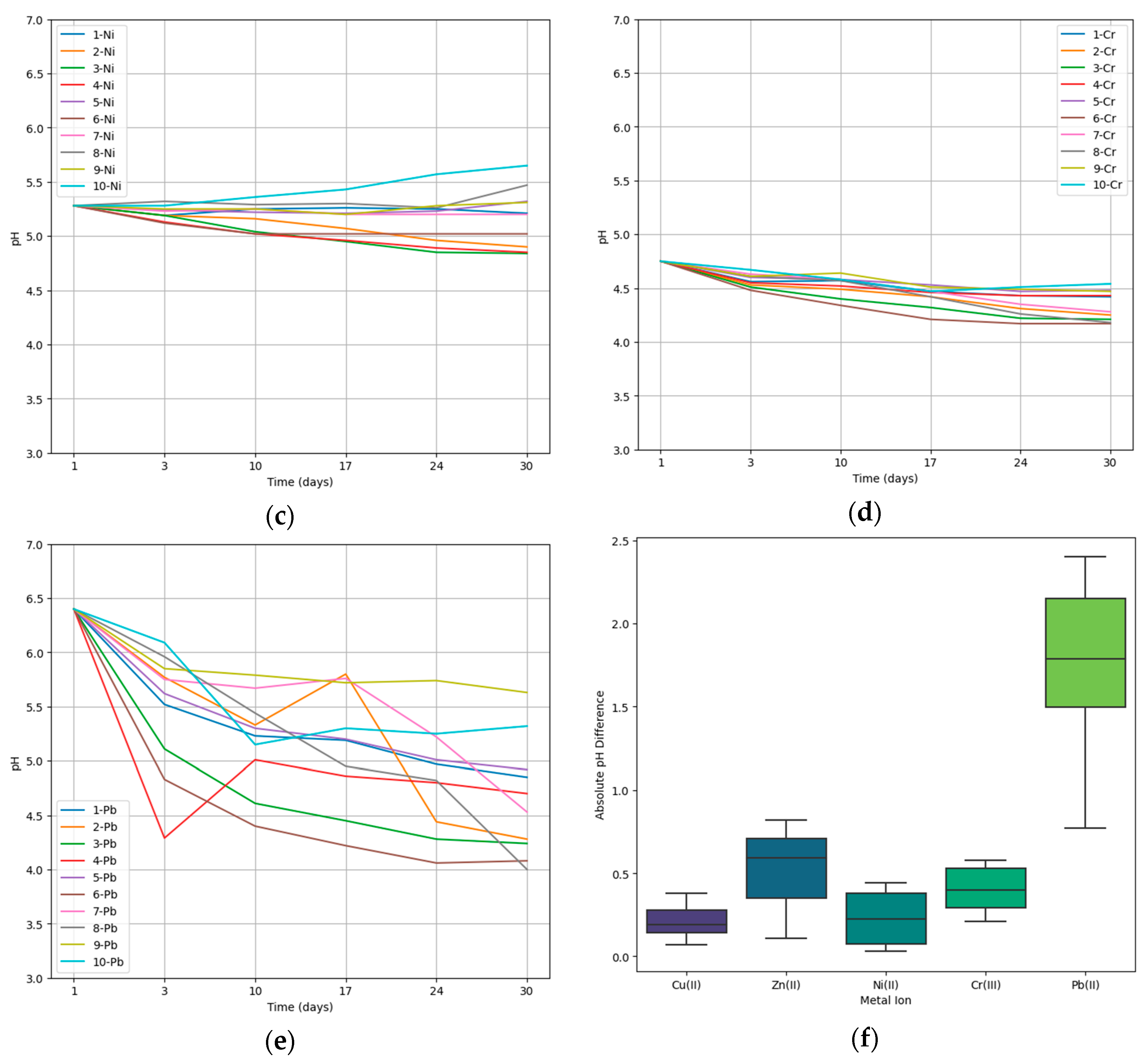pH Variation during Bioaccumulation of Selected Toxic Metals by Newly Isolated Microscopic Fungi from the Ostramo Lagoons †
Abstract
:1. Introduction
1.1. Characteristics of the Ostramo Lagoons Site
1.2. Effect of pH on Bioaccumulation of Toxic Metals
2. Materials and Methods
2.1. Characteristics of the Ostramo Lagoons Site
2.2. Experimental Bioaccumulation of Toxic Metals by Selected Species of Isolated Microscopic Filamentous Fungi
3. Results
4. Discussion
5. Conclusions
Funding
Institutional Review Board Statement
Informed Consent Statement
Data Availability Statement
Conflicts of Interest
References
- Farkas, B.; Vojtková, H.; Bujdoš, M.; Kolenčík, M.; Šebesta, M.; Matulová, M.; Duborská, E.; Danko, M.; Kim, H.; Kučová, K.; et al. Fungal mobilization of selenium in the presence of hausmannite and ferric oxyhydroxides. J. Fungi 2021, 7, 810. [Google Scholar] [CrossRef] [PubMed]
- Duborská, E.; Szabó, K.; Bujdoš, M.; Vojtková, H.; Littera, P.; Dobročka, E.; Kim, H.; Urík, M. Assessment of Aspergillus niger strain’s suitability for arsenate-contaminated water treatment and adsorbent recycling via bioextraction in a laboratory-scale experiment. Microorganisms 2020, 8, 1668. [Google Scholar] [CrossRef]
- Urík, M.; Polák, F.; Bujdoš, M.; Miglierini, M.B.; Milová-Žiaková, B.; Farkas, B.; Goneková, Z.; Vojtková, H.; Matúš, P. Antimony leaching from antimony-bearing ferric oxyhydroxides by filamentous fungi and biotransformation of ferric substrate. Sci. Total Environ. 2019, 664, 683–689. [Google Scholar] [CrossRef] [PubMed]
- Šimonovičová, A.; Ferianc, P.; Vojtková, H.; Pangallo, D.; Hanajík, P.; Kraková, L.; Feketeová, Z.; Čerňanský, S.; Okenicová, L.; Žemberyová, M.; et al. Alkaline Technosol contaminated by former mining activity and its culturable autochthonous microbiota. Chemosphere 2017, 171, 89–96. [Google Scholar] [CrossRef] [PubMed]
- Gadd, G.M.; Sayer, J.A. Environmental Microbe-Metal Interactions; Lovley, D.R., Ed.; ASM Press: Washington, DC, USA, 2000; p. 237. [Google Scholar]
- Šimonovičová, A.; Vojtková, H.; Nosalj, S.; Piecková, E.; Švehláková, H.; Kraková, L.; Drahovská, H.; Stalmachová, B.; Kučová, K.; Pangallo, D. Aspergillus niger environmental isolates and their specific diversity through metabolite profiling. Front. Microbiol. 2021, 12, 658010. [Google Scholar] [CrossRef] [PubMed]
- Nosalj, S.; Šimonovičová, A.; Vojtková, H. Enzyme production by soilborne fungal strains of Aspergillus niger isolated from different localities affected by mining. In Proceedings of the IOP Conference Series Earth and Environmental Science, Surakarta, Indonesia, 24–25 August 2021; Volume 900, p. 012027. [Google Scholar] [CrossRef]
- Zhao, X.; Huang, J.; Lu, J.; Sun, Y. Study on the influence of soil microbial community on the long-term heavy metal pollution of different land use types and depth layers in mine. Ecotoxicol. Environ. Saf. 2019, 170, 218–226. [Google Scholar] [CrossRef] [PubMed]
- Rajapaksha, R. Heavy metal tolerance of culturable bacteria and fungi in a long-term cultivated tropical ultisol. Eur. J. Soil Biol. 2011, 47, 9–15. [Google Scholar] [CrossRef]
- Zafar, S.; Aqil, F.; Ahmad, I. Metal tolerance and biosorption potential of filamentous fungi isolated from metal contaminated agricultural soil. Bioresour. Technol. 2007, 98, 2557–2561. [Google Scholar] [CrossRef]
- Blackwell, K.; Tobin, J. Cadmium accumulation and its effects on intracellular ion pools in a brewing strain of Saccharomyces cerevisiae. J. Ind. Microbiol. Biotechnol. 1999, 23, 204–208. [Google Scholar] [CrossRef]
- Gadd, G.M. Biosorption: Critical review of scientific rationale, environmental importance and significance for pollution treatment. J. Chem. Technol. Biotechnol. Int. Res. Process Environ. Clean Technol. 2009, 84, 13–28. [Google Scholar] [CrossRef]
- Šebesta, M.; Vojtková, H.; Cyprichová, V.; Ingle, A.P.; Urík, M.; Kolenčík, M. Mycosynthesis of metal-containing nanoparticles—Fungal metal resistance and mechanisms of synthesis. Int. J. Mol. Sci. 2022, 23, 14084. [Google Scholar] [CrossRef] [PubMed]
- Šebesta, M.; Vojtková, H.; Cyprichová, V.; Ingle, A.P.; Urík, M.; Kolenčík, M. Mycosynthesis of metal-containing nanoparticles—Synthesis by Ascomycetes and Basidiomycetes and their application. Int. J. Mol. Sci. 2023, 24, 304. [Google Scholar] [CrossRef] [PubMed]
- Bibbins-Martínez, M.; Juárez-Hernández, J.; López-Domínguez, J.; Nava-Galicia, S.; Martínez-Tozcano, L.; Juárez-Atonal’, R.; Cortés-Espinosa, D.; Díaz-Godinez, G. Potential application of fungal biosorption and/or bioaccumulation for the bioremediation of wastewater contamination: A review. J. Environ. Biol. 2023, 44, 135–145. [Google Scholar] [CrossRef]
- Argüello, J.M.; Raimunda, D.; González-Guerrero, M. Metal transport across biomembranes: Emerging models for a distinct chemistry. J. Biol. Chem. 2012, 287, 13510–13517. [Google Scholar] [CrossRef] [PubMed]
- Dursun, A.; Uslu, G.; Cuci, Y.; Aksu, Z. Bioaccumulation of copper (II), lead (II) and chromium (VI) by growing Aspergillus niger. Process Biochem. 2003, 38, 1647–1651. [Google Scholar] [CrossRef]
- Timková, I.; Sedláková-Kaduková, J.; Pristaš, P. Biosorption and bioaccumulation abilities of actinomycetes/streptomycetes isolated from metal contaminated sites. Separations 2018, 5, 54. [Google Scholar] [CrossRef]
- Igiri, B.E.; Okoduwa, S.I.; Idoko, G.O.; Akabuogu, E.P.; Adeyi, A.O.; Ejiogu, I.K. Toxicity and bioremediation of heavy metals contaminated ecosystem from tannery wastewater: A review. J. Toxicol. 2018, 2018, 2568038. [Google Scholar] [CrossRef]
- Valix, M.; Loon, L. Adaptive tolerance behaviour of fungi in heavy metals. Miner. Eng. 2003, 16, 193–198. [Google Scholar] [CrossRef]
- Ayele, A.; Haile, S.; Alemu, D.; Kamaraj, M. Comparative utilization of dead and live fungal biomass for the removal of heavy metal: A concise review. Sci. World J. 2021, 2021, 5588111. [Google Scholar] [CrossRef]
- Sintorini, M.; Widyatmoko, H.; Sinaga, E.; Aliyah, N. Effect of pH on metal mobility in the soil. In Proceedings of the IOP Conference Series: Earth and Environmental Science, Surakarta, Indonesia, 24–25 August 2021; Volume 737, p. 012071. [Google Scholar] [CrossRef]
- White, C.; Sayer, J.; Gadd, G. Microbial solubilization and immobilization of toxic metals: Key biogeochemical processes for treatment of contamination. FEMS Microbiol. Rev. 1997, 20, 503–516. [Google Scholar] [CrossRef]
- Fomina, M.; Hillier, S.; Charnock, J.; Melville, K.; Alexander, I.J.; Gadd, G. Role of oxalic acid overexcretion in transformations of toxic metal minerals by Beauveria caledonica. Appl. Environ. Microbiol. 2005, 71, 371–381. [Google Scholar] [CrossRef] [PubMed]
- Michalak, I.; Chojnacka, K.; Witek-Krowiak, A. State of the art for the biosorption process—A review. Appl. Biochem. Biotechnol. 2013, 170, 1389–1416. [Google Scholar] [CrossRef] [PubMed]
- Filote, C.; Rosca, M.; Hlihor, R.M.; Cozma, P.; Simion, I.M.; Apostol, M.; Gavrilescu, M. Sustainable application of biosorption and bioaccumulation of persistent pollutants in wastewater treatment: Current practice. Processes 2021, 9, 1696. [Google Scholar] [CrossRef]
- Vojtková, H. New strains of copper-resistant pseudomonas bacteria isolated from anthropogenically polluted soils. In Proceedings of the International Multidisciplinary Scientific GeoConference Surveying Geology and Mining Ecology Management, SGEM, Albena, Bulgaria, 17–26 June 2014; Volume 1, pp. 451–457. [Google Scholar] [CrossRef]
- Vojtková, H. Biodiversity of Pseudomonas bacterial strains isolated from Ostrava Lagoons, Czech Republic. In Proceedings of the 15th International Multidisciplinary Scientific Geoconference SGEM 2015, Albena, Bulgaria, 18–24 June 2015; pp. 291–296. [Google Scholar] [CrossRef]
- Xu, X.; Hao, R.; Xu, H.; Lu, A. Removal mechanism of Pb (II) by Penicillium polonicum: Immobilization, adsorption, and bioaccumulation. Sci. Rep. 2020, 10, 9079. [Google Scholar] [CrossRef] [PubMed]
- Paria, K.; Pyne, S.; Chakraborty, S.K. Optimization of heavy metal (lead) remedial activities of fungi Aspergillus penicillioides (F12) through extra cellular polymeric substances. Chemosphere 2022, 286, 131874. [Google Scholar] [CrossRef]
- Antsotegi-Uskola, M.; Markina-Iñarrairaegui, A.; Ugalde, U. New insights into copper homeostasis in filamentous fungi. Int. Microbiol. 2020, 23, 65–73. [Google Scholar] [CrossRef]
- Toledo, H.; Sánchez, C.I.; Marín, L.; Amich, J.; Calera, J.A. Regulation of zinc homeostatic genes by environmental pH in the filamentous fungus Aspergillus fumigatus. Environ. Microbiol. 2022, 24, 643–666. [Google Scholar] [CrossRef]
- Ge, W.; Zamri, D.; Mineyama, H.; Valix, M. Bioaccumulation of heavy metals on adapted Aspergillus foetidus. Adsorption 2011, 17, 901–910. [Google Scholar] [CrossRef]
- Ramya, D.; Kiruba, N.J.M.; Thatheyus, A.J. Biosorption of heavy metals using fungal biosorbents—A review. Fungi Bio-Prospect. Sustain. Agric. Environ. Nano-Technol. 2021, 2, 331–352. [Google Scholar] [CrossRef]
- Gadd, G.M. Interactions of fungi with toxic metals. In The genus Aspergillus: From Taxonomy and Genetics to Industrial Application; Springer: Boston, MA, USA, 1994; pp. 361–374. [Google Scholar]
- Robinson, J.R.; Isikhuemhen, O.S.; Anike, F.N. Fungal–metal interactions: A review of toxicity and homeostasis. J. Fungi 2021, 7, 225. [Google Scholar] [CrossRef]
- Karimi, H. Effect of pH and initial pb (II) concentration on the lead removal efficiency from industrial wastewater using Ca(OH)2. Int. J. Water Wastewater Treat 2017, 3, 1–4. [Google Scholar] [CrossRef]


| Fungi | Cu(II) | Zn(II) | Ni(II) | Cr(III) | Pb(II) |
|---|---|---|---|---|---|
| A. niger | 20.15 | 7.91 | 5.89 | 6.82 | 10.78 |
| A. candidus | 9.52 | 92.52 | 3.98 | 7.67 | 9.74 |
| A. iizukae | 5.96 | 29.54 | 14.26 | 21.15 | 1.43 |
| A. westerdijkiae | 21.07 | 47.66 | 7.13 | 7.66 | 4.47 |
| A. ochraceus | 57.42 | 56.88 | 6.68 | 37.73 | 2.24 |
| A. clavatus | 33.35 | 30.84 | 13.74 | 7.69 | 4.85 |
| Phoma sp. | 86.43 | 32.91 | 18.29 | 18.67 | 7.06 |
| Cystobasidium sp. | NA * | NA * | 2.46 | NA | 6.00 |
| Cladosporium sp. | 54.68 | 4.45 | 13.35 | 12.03 | 19.11 |
| Exophiala xenobiotica | NA * | NA * | 5.69 | NA * | 5.23 |
Disclaimer/Publisher’s Note: The statements, opinions and data contained in all publications are solely those of the individual author(s) and contributor(s) and not of MDPI and/or the editor(s). MDPI and/or the editor(s) disclaim responsibility for any injury to people or property resulting from any ideas, methods, instructions or products referred to in the content. |
© 2023 by the author. Licensee MDPI, Basel, Switzerland. This article is an open access article distributed under the terms and conditions of the Creative Commons Attribution (CC BY) license (https://creativecommons.org/licenses/by/4.0/).
Share and Cite
Vašinková, M. pH Variation during Bioaccumulation of Selected Toxic Metals by Newly Isolated Microscopic Fungi from the Ostramo Lagoons. Eng. Proc. 2023, 57, 7. https://doi.org/10.3390/engproc2023057007
Vašinková M. pH Variation during Bioaccumulation of Selected Toxic Metals by Newly Isolated Microscopic Fungi from the Ostramo Lagoons. Engineering Proceedings. 2023; 57(1):7. https://doi.org/10.3390/engproc2023057007
Chicago/Turabian StyleVašinková, Marketa. 2023. "pH Variation during Bioaccumulation of Selected Toxic Metals by Newly Isolated Microscopic Fungi from the Ostramo Lagoons" Engineering Proceedings 57, no. 1: 7. https://doi.org/10.3390/engproc2023057007





